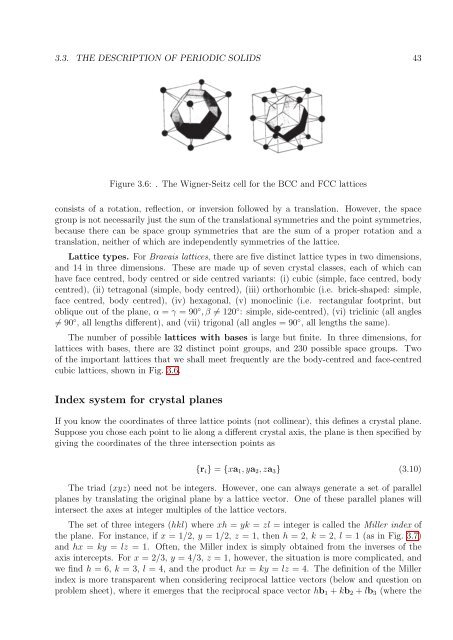Set of supplementary notes.
Set of supplementary notes.
Set of supplementary notes.
You also want an ePaper? Increase the reach of your titles
YUMPU automatically turns print PDFs into web optimized ePapers that Google loves.
3.3. THE DESCRIPTION OF PERIODIC SOLIDS 43<br />
Figure 3.6: . The Wigner-Seitz cell for the BCC and FCC lattices<br />
consists <strong>of</strong> a rotation, reflection, or inversion followed by a translation. However, the space<br />
group is not necessarily just the sum <strong>of</strong> the translational symmetries and the point symmetries,<br />
because there can be space group symmetries that are the sum <strong>of</strong> a proper rotation and a<br />
translation, neither <strong>of</strong> which are independently symmetries <strong>of</strong> the lattice.<br />
Lattice types. For Bravais lattices, there are five distinct lattice types in two dimensions,<br />
and 14 in three dimensions. These are made up <strong>of</strong> seven crystal classes, each <strong>of</strong> which can<br />
have face centred, body centred or side centred variants: (i) cubic (simple, face centred, body<br />
centred), (ii) tetragonal (simple, body centred), (iii) orthorhombic (i.e. brick-shaped: simple,<br />
face centred, body centred), (iv) hexagonal, (v) monoclinic (i.e. rectangular footprint, but<br />
oblique out <strong>of</strong> the plane, α = γ = 90 ◦ , β ≠ 120 ◦ : simple, side-centred), (vi) triclinic (all angles<br />
≠ 90 ◦ , all lengths different), and (vii) trigonal (all angles = 90 ◦ , all lengths the same).<br />
The number <strong>of</strong> possible lattices with bases is large but finite. In three dimensions, for<br />
lattices with bases, there are 32 distinct point groups, and 230 possible space groups. Two<br />
<strong>of</strong> the important lattices that we shall meet frequently are the body-centred and face-centred<br />
cubic lattices, shown in Fig. 3.6.<br />
Index system for crystal planes<br />
If you know the coordinates <strong>of</strong> three lattice points (not collinear), this defines a crystal plane.<br />
Suppose you chose each point to lie along a different crystal axis, the plane is then specified by<br />
giving the coordinates <strong>of</strong> the three intersection points as<br />
{r i } = {xa 1 , ya 2 , za 3 } (3.10)<br />
The triad (xyz) need not be integers. However, one can always generate a set <strong>of</strong> parallel<br />
planes by translating the original plane by a lattice vector. One <strong>of</strong> these parallel planes will<br />
intersect the axes at integer multiples <strong>of</strong> the lattice vectors.<br />
The set <strong>of</strong> three integers (hkl) where xh = yk = zl = integer is called the Miller index <strong>of</strong><br />
the plane. For instance, if x = 1/2, y = 1/2, z = 1, then h = 2, k = 2, l = 1 (as in Fig. 3.7)<br />
and hx = ky = lz = 1. Often, the Miller index is simply obtained from the inverses <strong>of</strong> the<br />
axis intercepts. For x = 2/3, y = 4/3, z = 1, however, the situation is more complicated, and<br />
we find h = 6, k = 3, l = 4, and the product hx = ky = lz = 4. The definition <strong>of</strong> the Miller<br />
index is more transparent when considering reciprocal lattice vectors (below and question on<br />
problem sheet), where it emerges that the reciprocal space vector hb 1 + kb 2 + lb 3 (where the








